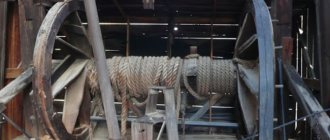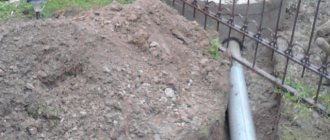Central water supply is a privilege for residents of urban centers. Even on the outskirts of a metropolis it is difficult to connect to communications. Either you need to spend a considerable amount on laying pipes, or access to the benefits of civilization is physically inaccessible due to the distance of utility networks.
There is nothing to say about isolated villages. The only way to get water is to drill your own well. The main thing is to find a suitable place. We will tell you the details about this important process, provide visual diagrams and show a thematic video.
Types of wells and wells
There are several types of wells, differing from each other in depth, and therefore in the quality of the water supplied. Shallow or sandy wells are drilled to a depth of 10 to 50 meters.
If the source is more than 50 meters deep, then it is considered artesian. It is characterized by a limestone layer, and it can only be broken through with special equipment.
Each type has its own drilling method. There are several technology options - rope-impact, perforated, rotary.
If you plan to break through a water source yourself, then manual drilling technology is also used. What you choose depends on the size of the planned burial, the type of soil, and the purpose of using water.
The most common types of water sources are a well, a sand well and an artesian well. They are characterized by their own depth, quality and volume of supplied water. They also differ in the type of soil in which they break through and in their service life.
Main types:
- well;
- on the sand;
- artesian
A well or Abyssinian well does not require special equipment to operate and can be made independently. A metal pipe with a sharp tip and holes in the walls is used.
The tube is driven into the ground to a depth of 8-10 meters. Thanks to the holes on the walls, the pipe is siege-proof and at the same time serves as a filter for the well. The soil type should not be hard.
The advantages of such a well include the ease of manufacturing on your own and the simplicity of the design. However, there are some disadvantages - it is impossible to install an in-depth pump, but only a surface one, due to the small diameter of the pipe.
As a result, it is not possible to provide sufficient water supply pressure. Another disadvantage is the relatively short service life, about 5 years.
Deepening into sand occurs to a level of 15-30 meters. A pipe is installed into the drilled hole, at the end of which a metal mesh made of stainless steel is attached. The mesh is designed to filter pebbles, which are rich in coarse-grained sands.
It is in these layers that the filtration pipe is installed. Such a water source can meet the needs of a country house. With constant use it will last 15 years.
an artesian well can cover all water needs and provide the house with crystal clear water . Drilling occurs to the level of calcareous rocks.
Therefore, the depth of artesian water can reach 200 meters. Such a source can provide more than 10 cubic meters of water per hour. Its service life is 50 years.
We install metal-plastic pipes with our own hands: the tools necessary for installation, as well as step-by-step instructions. How to remove iron from well water? Review of filters.
Well filter model
The depth of groundwater is 20-30 meters. A similar installation is used to provide water to small buildings (house, bathhouse, summer kitchen, shower). The composition of water obtained from sand wells can vary dramatically in quality: from polluted surface waters to deep, clear currents.
Note!
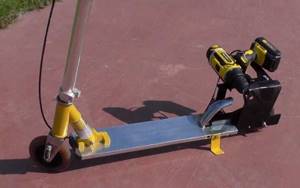
Do-it-yourself electric scooter - a master class with step-by-step instructions for doing it yourself. Tips and simple patterns for beginners + the best photo reviews

DIY rocking chair: TOP-120 photos of the best manufacturing options. Master class on creating a rocking chair at home
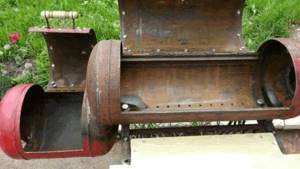
Smokehouse from a gas cylinder - the best master class on making a homemade smokehouse with step-by-step photo diagrams for beginners
Drilling methods and technology
The choice of drilling method depends on several factors. Basically, this is the depth level and type of soil that needs to be penetrated. In this regard, there are several types of drilling:
- Drilling using percussion-rope technology. To break through the soil layers, a special chisel and bailers are used to clean the hole. With the help of a chisel, cyclic destruction and crushing of the rock occurs. The method is used when drilling with a diameter of up to 50 cm. The main advantages of this method are working in hard layers of soil (boulder layers), and a clean water horizon after drilling. This allows the source to be put into operation immediately.
- Drilling using perforating technology. This method is used mainly for drilling Abyssinian wells and Igla type wells. The essence of the method is simple - one pipeline is assembled from pipe sections (1-3 meters) on a threaded connection, on which a sharp tip is attached. Then the assembled structure is driven into the ground to a depth of 8-10 meters, to the first aquifer. The advantage is the simplicity of the design and the ability to do everything yourself. However, there is also a minus - small depth.
- Rotary drilling. When using this method, a drill with a tip is installed in a special pipe. Drilling is carried out by creating a load on the drill using a hydraulic unit. The drill rotates from a rotor mounted on the surface. It is optimal to drill in loose rocks. You can go deep up to 300 meters. The quality and efficiency of the water horizon is maximized. However, with the involvement of special equipment for work, their cost increases.
- Manual drilling for water. This method may include various drilling technologies, but the most common are cable percussion drilling and perforated hydraulic drilling. To organize the process, tripods are installed on the site, on which a pipe with a bailer or headstock is suspended, depending on the method. It is advisable to manually drill a well if it is not possible to order the services of specialists, but there are physical resources for this.
Drilling with augers
A traditional auger is presented in the form of a metal rod with a working part on which the screw is located. Excellent for drilling soil of any composition.

To enhance drilling of rocky rocks, a bit is used. Instructions for the work performed:
- The threaded working part of the rod is screwed into the ground.
- Make several turns and remove the soil to the surface.
- As the shaft deepens, the threads on the working part are increased.
- To prevent the mine from collapsing as work progresses, casing pipes are installed.
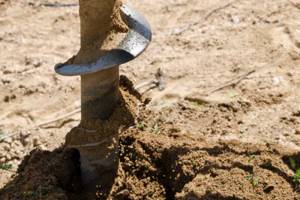
After completion of the work (for all methods used), filters, a pump (surface or deep) are installed and the well is pumped for the first time.

If necessary, and defects are identified, work is carried out to adjust the operation of the pump or equip the well. Be sure to pay maximum attention to the above-ground part of the well: tap, hoses, barrels, organized irrigation system.

Do-it-yourself water well drilling
Nature itself will help you determine the right location. Where plants grow more intensively, there is a possibility that the water table is shallow.
However, this recommendation is only valid for manual drilling, where the depth will be shallow. If you drill an artesian well, then such advice is useless.
The main criterion for a water source is cleanliness , so you need to distance it from potential pollutants by at least 25 m (drainage pits, toilet). also worth keeping a distance from home - no closer than 5 m . The well should not be located in depressions in the relief so that it does not become a sink for surface contaminants.
Drilling work. Drive well
Auger drilling
Without tripods it will be impossible to carry out the drilling process. You can make them yourself. You need to take 3 pipes 5 meters long. They need to be laid out on the ground so that the two sides at the top converge with each other, and at the bottom their edges diverge. Place a third one between them, in the middle.
Schematically, you should get a triangle divided in half. Then, through the joined edges, drill a hole into which to insert the fastening pin. Secure the edges of the pin so that the tripod does not move apart. The winch with a cable is attached to two side legs.
If you plan to use not impact technology, but to break through the soil with a drill, then you can also make it yourself. To do this, you will need a metal rod with a sharp end, to which the knives will be welded.
To make knives, you need to take metal disks 10-15 mm thick and cut them in half. Weld the first two halves at a height of 20 cm from the point of the rod.
When the shaft is positioned vertically, knives are welded to it at an angle of 200 from the imaginary horizontal. The opposite knife is welded crosswise to the first one at the same angle. The half-discs must be very well sharpened so that the drilling process takes place quickly and with minimal physical effort.
To drill an Abyssinian well, it is necessary to prepare pipes for driving in advance. They should be galvanized or stainless steel, one inch or three-quarters in size. Pre-cut threads for connection on each section.
Also in the initial section you need to weld the impact cone. From the tip to a height of up to 500 mm, 5-8 mm holes are drilled for the flow of water into the pipe, which are closed with a filtration mesh (P52 stainless steel).
To drive a pipe into the ground, you need a steel headstock with a round hole in the middle and two fasteners on the sides. The load must be heavy, more than 30 kg. The hole in the plate is placed on the pipe, and ropes are attached to its side fasteners.
To create a collision point on the pipe, a clamp is securely attached to it. Ropes are needed to lift the headstock. It is best to attach rollers on top of the tripods, through which you throw ropes. This will greatly facilitate the process of lifting the metal plate.
The metal plate hits the clamp with acceleration, thereby driving the pipe into the ground. As you deepen, the clamp must be moved upward and new pipe sections must be secured tightly to the threaded connection.
Video on how to drill a well with your own hands:
Another video on how to make a drill with your own hands:
If after the next blow the pipe goes into the ground unhindered, then the water horizon has been reached. It’s worth going deeper another half a meter and stopping.
After completing the drilling work, you need to cut off the excess pipe section and attach a check valve with a pump to it.
Well pump
In order for your water supply system to work as efficiently as possible, you need to choose the right pump for it. You can choose it based on several parameters:
- water level and depth;
- debit;
- diameter;
- need for water.
In order to reliably know the depth of the well and the water level in it, you can take a simple measurement. To do this, a load is suspended from a rope and lowered to the very bottom. The distance from the load to the wet edge of the rope will indicate what the water level is. And the total length of the rope immersion will be equal to the depth of the well.
These readings are important because they are stated in the pump passport, and are one of the main characteristics under which the drilling equipment will operate.
of a well is the volume of water produced by a source over a certain time. Based on this, you need to optimally select the right pump. You also need to decide on its size, because most equipment is made to fit 4 inches. If the well diameter is smaller, finding a pump will be much more problematic.
The motor, pumping 50 liters per minute, is capable of covering all the needs of an average family of up to 4 people. If your plans include watering large areas, then it makes sense to buy a pump with a capacity several times higher. Although the price will be higher, all water needs will be covered.
How to weld polypropylene pipes? Find out in this article. We choose and install the water meter correctly with our own hands.
How to make closed drainage around the house yourself? https://klimatlab.com/kanalizaciya/drenazh/drenazhnaya-sistema-vokrug-doma.html Useful recommendations.
Well construction and casing
To prevent the walls of the source from crumbling and the water to remain clean, casing pipes are used. The material used can be different - steel, asbestos cement, plastic. Which pipe to choose depends on the type of drilling, depth, hole diameter, and soil type.
Steel ones are the most expensive, and it is most advisable to use them in an artesian well on limestone. Another advantage of this use is that the service life of the metal casing pipes and the well itself are the same.
Asbestos-cement has a number of advantages. These include chemical neutrality, lack of corrosion and unlimited shelf life. However, there is a significant disadvantage - fragility, and as a result, increased wall thickness.
This leads to the fact that, with the same internal diameter, a larger external diameter will have to be punched under the asbestos-cement pipe. And this leads to higher costs of work. Most often, these pipes are used on limestone artesian wells.
plastic ones (there are PVC and HDPE) for wells with shallow depths (up to 50 meters), provided that there are no quicksand in the ground. Since the main disadvantage of PVC pipes is low strength, it is better to use them on simple soils. The advantages include the absence of corrosion and the impossibility of foreign components getting into the water due to the quality of the material.
Let's take a closer look at the features of the process
Well drilling - what is it?
The process consists of creating a vertical narrow shaft of the required length, which must reach the depth of the water, and drilling the well requires strengthening its walls with casing pipes. Pumping equipment is used for forced pumping of water into reservoirs for accumulation and distribution.
Cost and savings potential
The source of water supply for a private home should be economical, but the full price of its arrangement can be extremely high. You can reduce expenses by doing the preparation work yourself. Here are the savings on:
- Preparatory stage of the site, leveling the site for drilling work and placement of equipment.
- Digging trenches for laying pipes for domestic water supply.
- Arrangement of a pit for washing (the drilling crew does this with their own hands, it must be agreed upon in advance).
Drilling water wells (i.e. turnkey water supply) with your own hands helps reduce costs. But despite this, it is not necessary to perform such actions. For example, digging a pit and installing a caisson in it before drilling a well on the site. The construction of a source of water supply according to technology is carried out on the surface, which is why a pit is dug and a caisson is installed only after drilling work has been completed. The complex process of drilling water wells is the main service of special companies. They also provide a source of an autonomous system for supplying water, and also provide a warranty. beneficial in terms of the absence of additional expenses, saving time and the risk of the need for unscheduled repairs.
Advantages
Wells have many undeniable advantages. Due to them, wells are more preferable than wells. For this reason, they are becoming more in demand among owners of private property, which do not have the opportunity to provide a centralized water supply. Water wells have certain pros and cons, among the first:
- High quality drinking water – spring water, which is taken from the depths and is beneficial for human health.
- Duration of operation - well sources are drilled to great depths, and there are much greater water reserves there than in surface clay-type soils. This will determine a long service life, which is better than that of wells.
- Expenses for purification - water from the well does not mix with melt water that is in the ground. It will be effectively cleaned using a natural method, that is, thanks to natural filtration.
Let's move on to the drilling algorithm.
Well drilling stages
Phased drilling work is required for high-quality arrangement of the water supply source. In this case, many factors are taken into account. This includes the depth of the well for clean water, preparation of the site and facility, dismantling of the drill and equipment.
Special companies perform work in several stages:
- Drawing up a contract, and all work items will be spelled out in it.
- Preparatory stage of soil for installation of equipment.
- Delivery and installation of special equipment and equipment at the drilling site.
- Production of wells and its casing with pipes.
- Arrangement of a water source (will depend on its type - seasonal use, arrangement of a caisson, installation of equipment in a building room).
- Testing the well for water inflow from the aquifer, pumping it to the beginning of a clean water source, and testing the work is carried out in different water intake modes.
- Delivery of the completed facility to the customer - a working demonstration of the water supply source, an assessment of its performance, water quality, and the signing of a work completion certificate. We are also talking about the dismantling of drilling rigs, equipment and equipment.
We suggest we talk about technologies, of which there are only 5 pieces.


